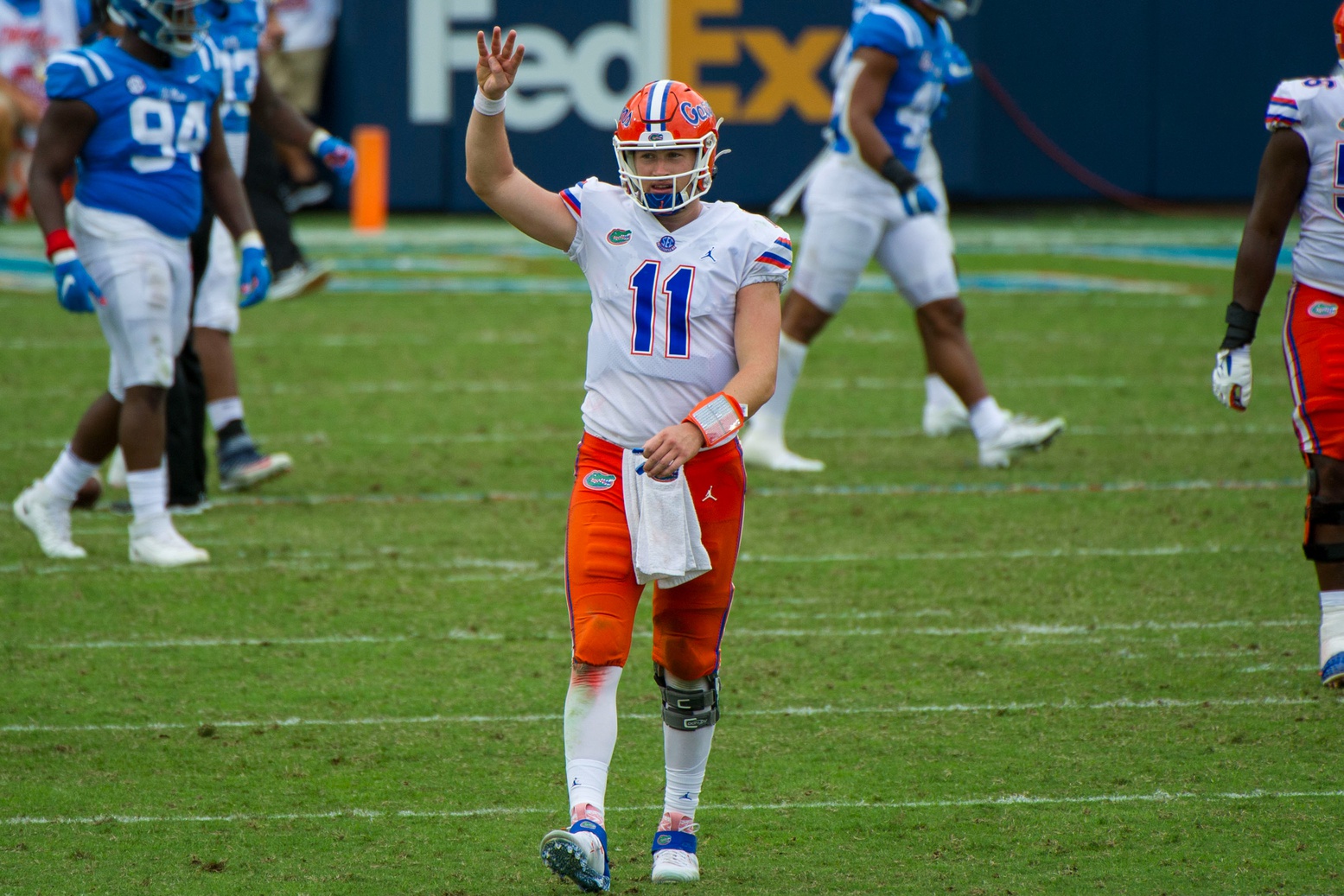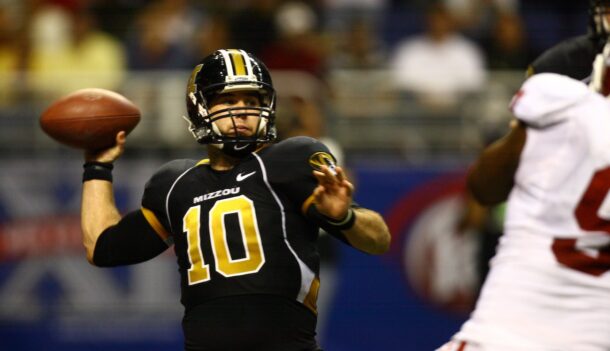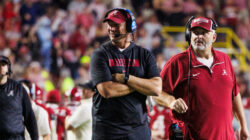
With all due respect to Pro Football Focus, yes, Kyle Trask is an elite SEC quarterback
I read Pro Football Focus consistently and respect the fine folks over there.
For the 6 seasons that I’ve been working for this company, I’ve used them as a resource. I’ve reached out to their analysts to clarify a grade and break down a draft prospect. I’ve interviewed them for stories and podcast purposes, as well. It opened my eyes to things like how Jaycee Horn had only allowed 2 touchdowns in 1,426 career snaps entering 2020 or that Drake Jackson had only allowed 1 sack in 974 pass-block snaps entering 2020. With all the resources that we have in 2020, I’m glad that there’s a publication like Pro Football Focus that breaks down every player from every game.
But no, I don’t agree with PFF’s continued takedown of Kyle Trask. At all.
If you’re unfamiliar with what I’m talking about, you likely missed PFF’s story titled “Treash: Why Florida’s Kyle Trask is not an elite SEC quarterback.” Mind you, this came after PFF ranked Trask as the No. 66 FBS quarterback at the end of the 2019 season.
That’s right. The 2019 season that saw Trask produce 29 touchdowns in 10.5 games and complete 60% of his passes in all but 1 game he started for a New Year’s 6 bowl champion was worthy of a middle-of-the-pack end of season ranking. In case you were wondering, there was no mention of Florida’s poor offensive line that Trask had to deal with.
Why was PFF so low on Trask then? Well, as they put it back in January, “Trask launched just 9 big-time throws compared to his 22 turnover-worthy passes, a mark that certainly isn’t pleasing on the eyes.”
So one would assume that the 2020 critique of him is more of the same, right? Nope. As PFF’s Anthony Treash even admitted, those have been areas of improvement:
“Last year, Trask had the 4th-worst big-time throw to turnover-worthy play differential in the FBS, at -13 (9 to 22). Through 3 games this season, Trask has nearly matched his big-time throw total from last year (8) and is on pace to cut his turnover-worthy play rate in half.”
Also, PFF had Trask as the No. 3 downfield passer in FBS after his first 2 games. Just sayin’.
Treash wrote that we cannot get consumed by the box score when it comes to Trask. Throwing for 996 yards, 14 touchdown passes and 1 interception with a 72% completion percentage and 9.7 yards per attempt isn’t what it appears, Treash argued. After all, Treash pointed out, Dan Mullen is incredibly good at scheming and Trask’s pass-catching targets have been fantastic without his help. Duh. Any quarterback can throw for at least 4 touchdowns, 9 yards per attempt and complete 71% of his passes in 3 games vs. SEC competition, right?
Plus, Trask faced Ole Miss, and in case you haven’t watched any Ole Miss games this year, well, let’s just say that defense is a special level of awful. According to Treash, we should throw out that game for Trask because that Ole Miss defense can skew things.
The irony is that Trask is ranked behind Feleipe Franks in Pro Football Focus’ ranking of SEC quarterbacks. Who did Franks just face and have 1 touchdown against? Ole Miss. The other irony is that PFF did a 2021 mock draft immediately after Trask played Ole Miss — it was done by PFF’s Mike Renner — and it had him going No. 15 overall to the Las Vegas Raiders.
But sure, let’s just take away that 1/3 of the season for Trask.
Here’s what Treash is really hung up on — he believes Mullen and Florida’s pass-catchers are making Trask looking significantly better than he is:
“On throws of 9 yards or fewer downfield this season, Florida’s receiving unit has averaged the most yards after the catch per reception (8.7) and have turned 28% of such catches into an explosive play of 15 or more yards — 10 percentage points higher than any other SEC team. And Trask has generated a 130.4 passer rating on these throws, which also leads the SEC.”
PFF cited that last year, Trask threw to receivers with a step of separation on 41% of his throws. That number is up to 55.5% this year, which suggests what we already knew. Mullen is an excellent schemer and Florida’s pass-catchers are pretty darn good at getting open.
The problem is that according to PFF, Trask is dead last in the SEC in terms of positively-graded throw percentage on explosive pass plays. In other words, PFF’s system argues that Florida isn’t making big plays because of Trask, but rather because what the receivers are doing.
This play here that Treash used was his closing argument. Florida fans remember it well because Kadarius Toney put on a nasty double move, caught Trask’s pass and then ran through 5 South Carolina defenders en route to the end zone:
“Kyle Trask has 996 passing yards and 14 touchdowns through three games and Florida has one of the best offenses in the country. How is he not your highest-graded QB?” pic.twitter.com/i3ssguHDre
— Anthony Treash (@PFF_Anthony) October 16, 2020
Treash, whether he realizes it or not, picked a bad example. Yes, Toney is an absurd human being. This is more likely to go on his highlight reel than Trask’s. Obviously.
But while Toney’s moves in the open field were the highlight, why are we discounting what Trask did to get him the ball in stride?
I watch that play and I see Trask recognize that he has front-side pressure coming his way and if he wants to target anyone, he needs to create some space to get off a clean throw. Trask also correctly spots that he has a spy middle linebacker who is going to take off for him as soon as the threat of a run appears.
Not only does Trask dissect both dangers, he also steps into a throw coming across the left side of his body and hits Toney perfectly in stride. If Trask makes Toney come back to the ball at all, he doesn’t hit the second level with a head of steam.
To recap, Trask bought time to allow Toney to make that absurd double move, he was willing to take on a shot from middle linebacker barreling down on him and he delivered an on-target throw while moving to the left side of his body.
Call me crazy, but that’s the sign of a pretty darn good quarterback.
If you’re going to argue that Trask is average, I suppose that’s your business. I see someone who has immensely improved his footwork in the pocket (PFF had Trask as the No. 2 graded FBS QB outside of the pocket after his first 2 games) and is delivering on-target throws to his ridiculously talented pass-catchers. Maybe Trask doesn’t get the top grade for throwing what appears to be a jump ball to Kyle Pitts in double coverage. I get that. Pitts does the heavy lifting.
But there’s a certain rapport that a quarterback needs to have with his pass-catchers to trust them to make plays. Watch Florida for 5 minutes and that rapport couldn’t be more obvious. Watch someone like Jake Fromm for 5 minutes last year and you’d see that lack of rapport with his pass-catchers couldn’t be more obvious.
I don’t care about what PFF says about Trask’s EPA (expected points added). You don’t complete 68% of your passes and record a 40-8 touchdown-interception ratio in your career as an SEC quarterback by being average. I’m sorry if that’s too much “lazy box score” analysis.
I, too, have watched every game that Trask has played. I’ve watched that offense soar to new heights with him. That’s why Franks is at Arkansas. That’s why Emory Jones still can’t get a start in Year 3 at Florida. That’s why the offense has averaged 41 points in its last 5 games even though it didn’t even run for 100 yards in 3 of those games.
If you have questions about Trask as an NFL prospect because you don’t think he has the arm strength or that you wonder how he’s going to look once he doesn’t have Mullen dialing up plays, sure. And if you think among SEC quarterbacks that Mac Jones is the best signal-caller, I don’t necessarily have a problem with that, either.
But let’s not overthink this — Trask is an elite SEC quarterback in every way.
Connor O'Gara is the senior national columnist for Saturday Down South. He's a member of the Football Writers Association of America. After spending his entire life living in B1G country, he moved to the South in 2015.







